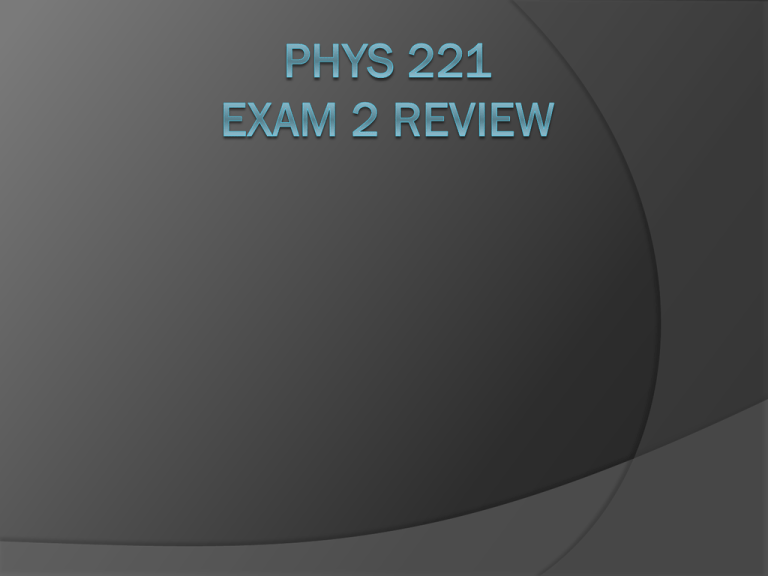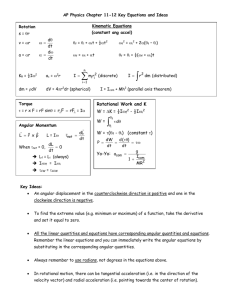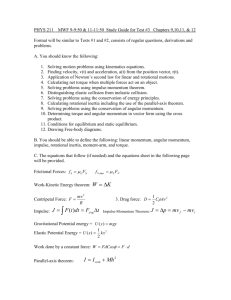Phys 221 exam 2 review
advertisement

Reminders: NO SI THURSDAY!! Exam Overview “Approximately 1/3 of the problems will stress understanding of the physics concepts, whereas the remainder will be numerical problems to test ability to apply these concepts.” -Syllabus 27 Questions Statistical Breakdown of Exam 2 26% Energy 17% Collisions (+Momentum) 46% Rotational (Center of mass, moment of inertia, statics, angular momentum, torque) 10% Gravitational Let’s put some analogies to work: Not knowing gravitation would be like losing 3 fingers Not knowing rotational is like losing a heart or both lungs Energy Conservation of Energy Conservative/Non-conservative Potential Energy Springs Collisions Rotational Gravitational Force/PE KE 2 types 1 Rotational 𝐾𝐸 = 𝑚𝑣 2 2 1 Translational 𝐾𝐸 = 𝐼𝜔2 2 Springs A 10 kg mass hits a spring at a speed of 50 m/s. The spring has k=30 N/m. How far will the spring be compressed? What will the PE of the spring be when it is fully compressed? What will the PE of the spring be when it is halfway compressed? Conservation of Energy Find a method that works for you. What’s most important is that you fully understand your method, front and back. For me, I prefer doing one of two things: If there’s no friction, I just write out the energy at the two points. If there is friction, I use 𝑊𝑜𝑡ℎ𝑒𝑟 = Δ𝑃𝐸 + Δ𝐾𝐸 𝑊𝑜𝑡ℎ𝑒𝑟 =Work done by forces other than gravity Define Mechanical Energy 1. KE 2. PE 3. KE+PE Given a PE graph or function, what is F? 𝑈 is just another symbol for 𝑃𝐸 Where are the stable and unstable equilibriums? At what points is the force zero? At what points is the force negative? Where does the particle have maximum speed, if it’s released at x=4? 𝑑𝑈 − 𝑑𝑥 𝐹= Recall that at equilibriums, the force is 𝑑𝑈 zero. AKA =0 𝑑𝑥 You’re given 𝑈 = 20𝑥 3 What is F at x=-2? Conservative Forces vs. Non-conservative Forces Conservative Always associated with some PE Work doesn’t depend on path taken Examples: Gravity, Electrostatic Not Conservative PE doesn’t exist Work does depend on path Examples: Friction, Air resistance Collisions 𝑷 = 𝑚𝒗: Momentum is a vector Conservation of momentum Impulse 𝑱 = 𝚫𝐏 Elastic, Inelastic, Completely Inelastic Deciding elasticity Do they tell you it’s elastic, inelastic, or completely inelastic? Yes Does the problem say the objects stick together after the collision? No Yes No It’s completely inelastic (KE not conserved) What is the Δ𝐾𝐸 of the collision? 0 <0 Elastic Inelastic (could be completely inelastic, but doesn’t have to be) Is Momentum Conserved in a Collision In this course, YES, ALWAYS! Impulse Impulse J: 3 ways to define 𝑱 = Δ𝐏 𝑱 = ∫ 𝑭𝑑𝑡 𝑱 = 𝐹Δ𝑡 𝑓𝑜𝑟 𝑐𝑜𝑛𝑠𝑡𝑎𝑛𝑡, 𝑎𝑣𝑒𝑟𝑎𝑔𝑒 𝑓𝑜𝑟𝑐𝑒 The impulse of A on B is equal and opposite to the impulse of B on A A 5 kg ball hits a wall at 8 m/s and bounces back at the same speed. If the collision took 4 seconds, what is the average force done by the wall on the ball? Rotational Moment of Inertia=Rotational Inertia: 𝐼 = 𝑚𝑖 𝑟𝑖2 (about some axis) Torque 𝜏 = 𝒓 × 𝑭 (about some axis) 𝜏 = 𝛼𝐼 (about some axis) Angular momentum 𝑳 = 𝒓 × 𝒑 = 𝒓 × 𝑚𝒗 (about some axis) Notice how everything angular is about some axis. Make sure that your choice of axes match. Center of Mass!! Center of Mass!! Why is this important/grouped under rotation? = Solve… Mathematically… Intuitively Do circular or non-circular go faster down hills? Angular momentum is the same for the two systems below about an axis through O. Discrete/Continuous…which formula should I use? Discrete: 𝐼 = ∑𝑚𝑖 𝑟𝑖2 Discrete: 𝐋 = ∑𝒓 × 𝑚𝒗 Continuous: 𝐼 = ∫ 𝑟 2 𝑑𝑚 (use equation sheet for this) Continuous: 𝐋 = 𝐼𝝎 Worked example What is the angular momentum? Parallel Axis Theorem (PAT): 𝐼 = 2 𝐼𝑐𝑚 + 𝑀𝑑 Torque (𝜏 = 𝑟 × 𝐹 = 𝐼𝛼) If net torque is zero, an object can still be moving. In fact, the object can even be accelerating! However, the angular acceleration must be zero, and the angular velocity must be constant. Comparison between linear and angular Notice that there’s always an axis involved with every single rotational equivalent! 𝒙 (Position) 𝜃 (Angular position) 𝒗 (Linear velocity) 𝝎 (Angular velocity) 𝒂 (Linear acceleration) 𝜶 (Angular acceleration) 𝑚 (𝑴𝒂𝒔𝒔) 𝑭 = 𝑚𝒗 (Equation for force) I (Moment of Inertia) 𝝉 = 𝐼𝝎 (Equation for torque) 𝝉 = 𝒓 × 𝑭 (Equation relating force and torque) 𝑳 = 𝒓 × 𝒑 (Definition of angular momentum) 𝐏 = m𝐯 (Definition of linear momentum) 1 𝐾𝐸𝑡𝑟𝑎𝑛𝑠 = 2 𝑚𝑣 2 (Definition of translational KE) 𝑭= 𝑑𝒑 𝑑𝑡 (Force-momentum relation) 1 𝐾𝐸𝑟𝑜𝑡 = 2 𝐼𝜔2 (Definition of rotational KE) 𝑭= 𝑑𝒑 𝑑𝑡 (Torque-angular momentum relation) 𝚫𝐏 = ∫ 𝐅 ⋅ dt (Impulse equation) 𝚫𝐋 = ∫ 𝝉 ⋅ dt (Angular Impulse equation) 𝑃 = 𝐹𝑣 (Power and constant force, constant velocity relation) 𝑊 = ∫ F dx (Work caused by force) P = 𝜏𝜔 (Power and constant torque, constant angular velocity relation) 𝑊 = ∫ 𝜏 𝑑𝜃 (Work caused by torque) Statics Can be solved in 2 minutes Strategy: Generally, use conservation of angular momentum first! Both discrete and continuous! Is Momentum Conserved? Is Angular Momentum Conserved? Gravitation 𝐹= 𝐺𝑚𝑀 𝑟2 𝑃𝐸𝑔 = 𝐺𝑚𝑀 − 𝑟 𝑇 = 2𝜋 𝑟3 𝐺𝑀 Equation relating the period of a planet’s motion around a star of mass M NOTE: r is the distance between the two masses, M is the mass of the object being orbited. Examples: A planet is in a circular orbit around a star. The mass of the star is 5 * 1028 kg. If the period of the planet’s orbit is 1.00 * 105 s, then the orbital radius of the planet around the star is ____ m. The centers of two small uniform spherical bodies are separated by a distance d and the magnitude of the attractive gravitational force of one on the other is F. If the distance between the centers of the bodies decreases to d/2, the magnitude of the force of one on the other becomes ____ . A 1.53-kg mass hangs on a rope wrapped around a disk pulley of mass 7.07 kg and radius 66.0 cm. The rope does not slip on the pulley. What is the angular acceleration of the pulley? If the block has fallen 0.8 m, what is the speed of the block at that time? (Two ways to solve this) Other Concepts Magnitude of Forces, vectors, etc… Multi-Principle Problems A Trickier Problems







